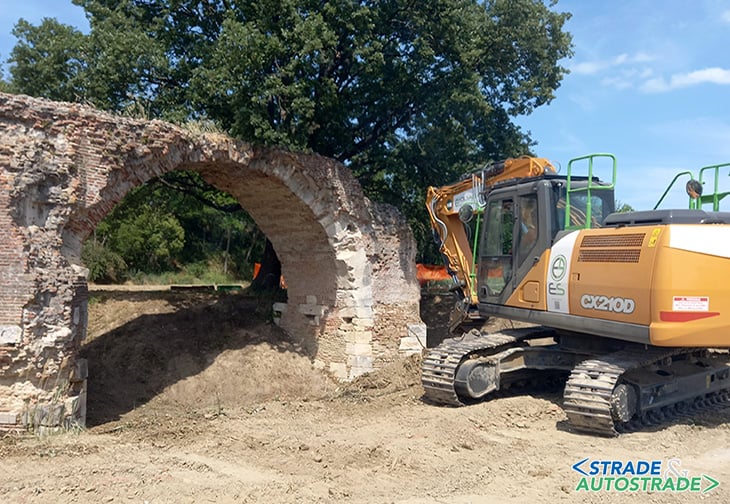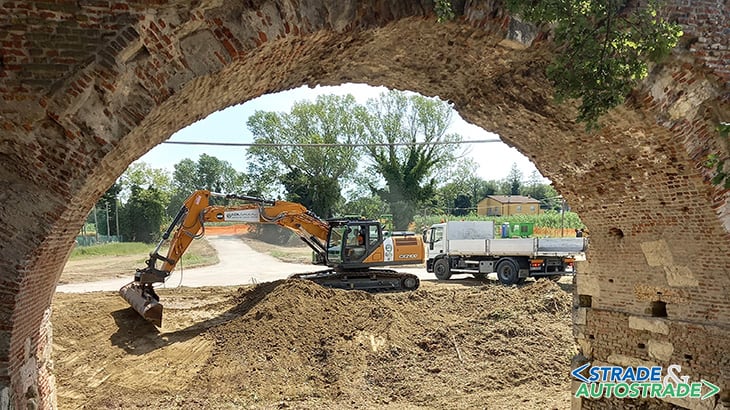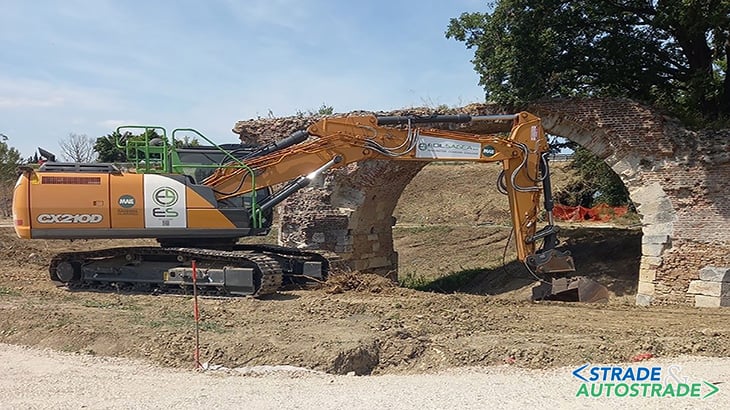Last October, the archaeological area of San Vito, on the border between the municipalities of Rimini, San Mauro and Santarcangelo di Romagna began and for the future is planned a connection to the sea via a cycle-pedestrian path.
![]() Per la versione in Italiano: https://www.stradeeautostrade.it/movimento-terra/alea-iacta-est/
Per la versione in Italiano: https://www.stradeeautostrade.it/movimento-terra/alea-iacta-est/
At the centre of the project are the remains of the roman bridge next to which the Uso river flows, which several historians claim was the Rubicon crossed by Julius Caesar. The waterway is said to have represented the boundary of the colony of Ariminum and the Republic of Rome, within which weapons could not be entered.
The famous phrase “The die is cast”, reported in Latin by the Biographer Suetonius, was uttered by Caesar in January 49 b.C. while crossing the Rubicon, the first move towards the conquest of Rome and its Mediterranean empire.
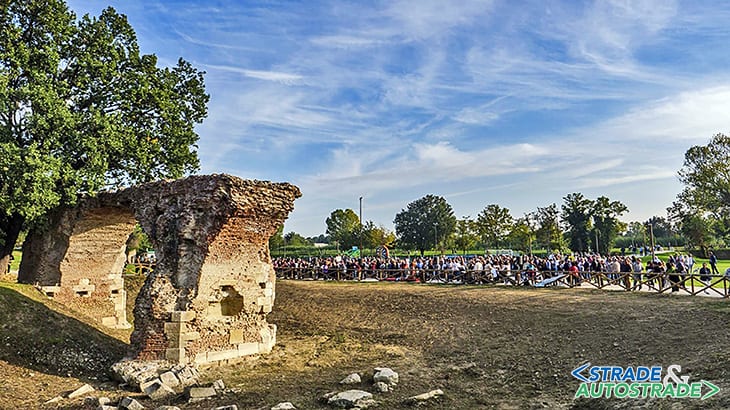
The eight-arched structure of the San Vito bridge, brought to light by recent archaeological excavations is longer than the Tiberius Bridge in Rimini and evidently of strategic importance.
The redevelopment of this historic bridge has revived an important part of Rimini’s historical heritage, and was managed by the Municipal Administration, entrusted to the Con.co.s. Consortium, and carried out by one of its member Companies, Edilsagea Srl, of Sant’Arcangelo di Romagna.
The jobsite in detail
The machine that took care of restoring the bridge and the archaeological area to its former glory was a Case CX210D crawler excavator (photo 1). During the first phase of the work, which took place in May 2022, excavation, slope cleaning and soil shaping were carried out (https://www.casece.com/en-gb/europe).
Afterwards, Edilsagea created a ring-shaped path linking the ruins, the ancient route of the Via Emilia and the Uso river in order to upgrade and make the entire area usable.
New paving, benches and flower beds now enhance the route of the old Via Emilia, which starts from the churchyard of Saints Vito and Modesto. From there, it continues towards the area of the archaeological excavations, where it connects with the access from the driveway to the south, which has become the new main entrance to the area. The access ramp forms an optical telescope towards the remains of the bridge, allowing an overall view of the excavation area.
In front of the bridge is the first “piazza” (of approximately 300 m2) paved in architectural concrete with exposed gravel – like the paths around the excavation area – which makes theatrical activities, open-air events or historical re-enactments viewable from the surrounding lawn.
The path continues by skirting the excavation area of the bridge in a circular direction and continues on the North side, below the escarpment of the Via Emilia Vecchia. At the back of the bridge is another rest area: the Belvedere area – it is here that people can enjoy the best views of the surrounding area.
Edilsagea also planted numerous native trees and shrubs and, to recall the position of the pylons of the old Roman bridge, which are no longer visible, white hornbeams were planted to accompany the walk towards the river.
All the paths are lined with street lights that ensure that the entire archaeological area is safe to walk along, even in the evening hours (photo 2A and 2B).
A 0 km Company for the redevelopment of the archaeological area
Edilsagea and the Consortium Con.co.s. soc. cooperativa have carried out the redevelopment of the archaeological area of the Roman bridge of San Vito. For the work in question, the Case CX210D crawler excavator was chosen.
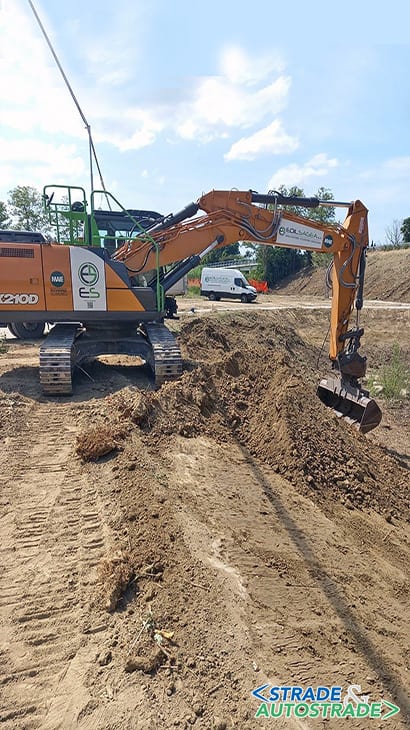
Nicola Detti, who together with his father Andrea manages the Romagna-based Company, tells us: “The Case excavator carried out the cross-section excavations for the installation of the systems, the earthworks for profiling the ground around the Roman bridge, and above all the reprofiling of the embankment with a swivelling oscillating bucket.
He continues: “It is a very versatile machine, our operators appreciate its speed of execution, which does not compromise on the manoeuvrability and sensitivity of the hydraulic system, which is very smooth and precise.
The excavator worked on the job approximately 150 hours in 30 days, allowing the Company to finish the work on time.
Not only archaeology, but also riverbed cleaning and sea shore nourishment
The Romagna-based Company is active in various sectors: from urbanisation works to road works, from hydraulic works to river and maritime works (photo 4), as well as demolition.
The Company’s excavators work in two contexts: the construction of groynes and reefs within riverbeds, where the presence of rocky terrain puts the vehicle’s undercarriage to the test; and the nourishment of the seashore, where the wear factor is undoubtedly the salinity of the working environment, which challenges all the mechanical moving parts.
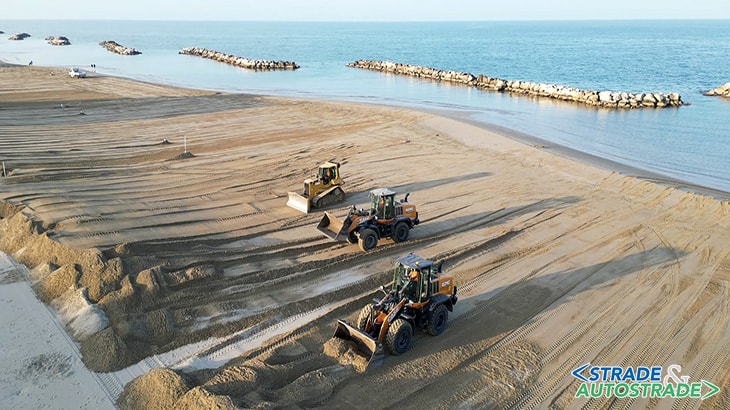
“The choice of vehicles is crucial for us. They must always be the best machines, and with the Case machine we have never had any problems. A little anecdote: with the Case CX240D, one of our operators – while mulching vegetation on the Marecchia river in Rimini – touched, causing it to burst, a medium voltage Enel cable uncovered and surfacing on the riverbank.
Despite the large explosion caused, the operator in the cabin was completely isolated and did not suffer any injuries. We are sure that if it had happened with an older vehicle, I would not be here to recount this story lightly.
The operator thanked us several times for our attachment to the vehicle fleet, which we continually renew and keep in maniacal condition’ (photo 5).
Francesco Mustaro, Area Manager Emilia Romagna, and Marco Manenti, Sales Officer of Maie, Case dealer based in Ravenna, tell us: “Maie has for years had the honour of being a partner of Edilsagea, a flagship Company on the Riviera, for the professionalism and passion with which it carries out its work on a daily basis. With them, we are happy to be able to contribute to the recovery and enhancement of our territory with means that are up to the mark and safe”.
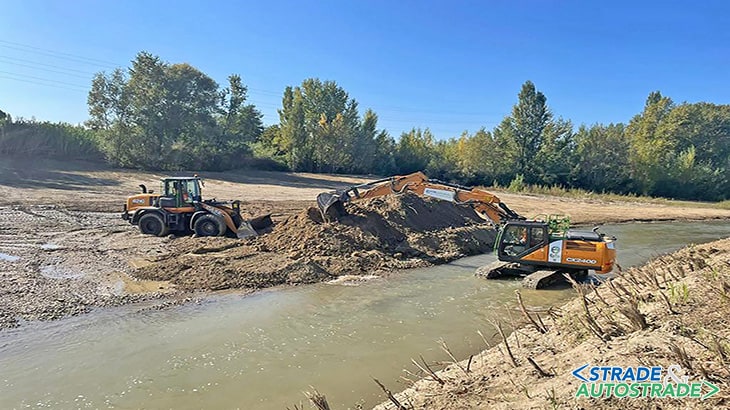
Technical data
- General Contractor: Anthea Srl (municipality of Rimini)
- Works director: Arch. Uguccioni Fabio
- Main works: Cat. OG3 – road infrastructure
- Amount: 272,000 Euro
- Duration of the works: year 2022
![]() Per la versione in Italiano: https://www.stradeeautostrade.it/movimento-terra/alea-iacta-est/
Per la versione in Italiano: https://www.stradeeautostrade.it/movimento-terra/alea-iacta-est/

